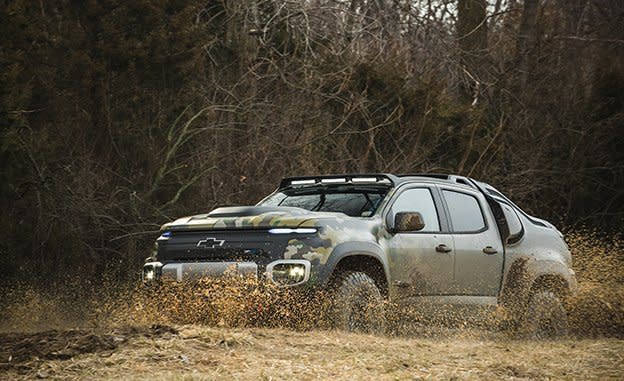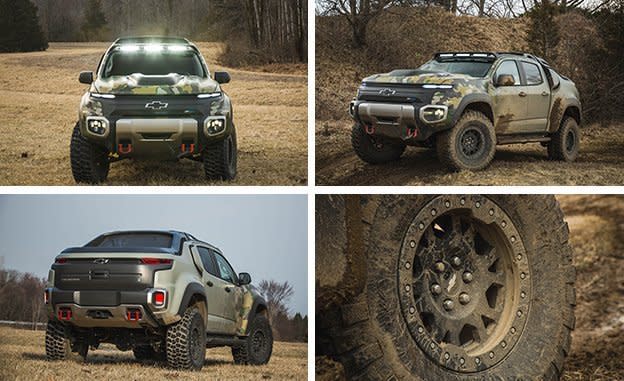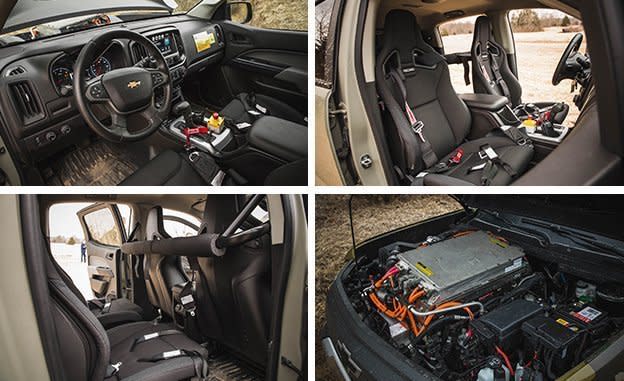Chevrolet Colorado ZH2 Concept: An Experiment with an Eye toward the Military Vehicles of Tomorrow

If you are anything like us, the first question you have when learning about a hydrogen-powered military vehicle is basically this: “So, what happens when, you know, people shoot at the hydrogen tanks?” Charlie Freese, General Motors’ executive director of global fuel-cell activities and our driver today, assures us that the tanks—which store hydrogen at 10,000 psi—are basically bulletproof.
“Fifties bounce off the [hydrogen] tanks,” he says, referring to .50-caliber rounds. More specifically, he’s talking about the .50 BMG, a rifle cartridge that is essentially a supersonic hot dog with the kinetic energy of a 2500-pound car going about 10 mph—except that, on impact, all of its energy is concentrated in an area smaller than a dime, not spread across an energy-absorbing bumper. Bouncing off the hydrogen storage tanks is a good thing. If a breach of the tank is detected, the Chevrolet Colorado ZH2 concept vents its volatile hydrogen directly up. Venting, too, is good.

This Colorado ZH2 is the product of a joint venture between GM and TARDEC—the U.S. Army’s Tank Automotive Research, Development, and Engineering Center—that has been 10 years in the making. It isn’t battle ready; this truck is a proof-of-concept project, meaning it is a demonstrator to prove the suitability of a fuel-cell stack in military service. GM revealed the truck last fall and has just turned it over to the Army, where officers and enlisted soldiers will spend about a year evaluating its effectiveness and attributes.
On paper these attributes—namely a low heat signature and near silent operation—sound more like video-game upgrades than they do ones for real life. The loudest noise the 93-kW fuel cell makes is a Darth Vader–like huffing on startup and shutdown. The heavy breathing is to purge the system of water, which, like the electricity the stack produces, occurs when the fuel cell combines hydrogen with oxygen. If a fuel-cell-powered military vehicle makes it to production, the water produced is likely to be captured, filtered, and used by troops, although probably for washing and cleaning rather than for drinking.
The Cool, Quiet Type
A Humvee on patrol does anything but hum. It needs to keep its diesel engine running to maintain a healthy flow of electrons to its reconnaissance electronics, which also make their own heat. In all, a Humvee radiates about 750 degrees of detectable heat that thermal-imaging systems can detect from more than three miles away. The ZH2’s fuel-cell electric drivetrain has a heat signature of roughly 140 degrees, detectable from about 1.2 miles.

The hydrogen fuel cell also is much quieter, not only at idle but also in operation. During our two-hour exposure to the ZH2 at GM’s Milford Proving Ground, we mostly rode shotgun while Freese drove it over whoop-de-dos at a decent clip. But we also watched as the ZH2 climbed a 15-foot berm and disappeared silently behind it. With no engine note, the ZH2 is effectively undetectable to the human ear until it is right on top of you. We can’t help but think American forces would love this stealthy truck for that attribute alone.
Not Quite There Yet
This concept is a mashup of in-house parts. The frame is a stretched version of the one that underpins the pedestrian Chevrolet Colorado. It is also fitted with 37-inch tires and the fancy spool-valve dampers and off-road suspension borrowed from the Colorado ZR2 prerunner. The proton-exchange membrane (PEM) fuel cell and the electric motor are direct transplants from the Equinox fuel-cell research vehicle. So, too, is the relatively small battery, which acts as a buffer for electricity generated by the fuel cell. A tumorous-looking hood bulge accommodates the fuel-cell stack atop the 177-hp electric motor, while heat exchangers occupy the hunchback behind the cab. GM and TARDEC say the visibility and packaging will improve because the powertrain will be 40 percent smaller in production—although unrelated to a fuel-cell stack, also said to be more compact, the powertrain will be built under a GM/Honda partnership in 2020.
A four-wheel-drive transfer case and beadlock wheels—which allow low tire pressures without fear of popping the tire off of the wheel rim—give the ZH2 plenty of off-pavement traction. It has a low range in its transfer case, but Freese never engages it. The direct-drive transmission and low-end grunt of the electric motor produce more than enough torque to crawl over downed telephone poles. The nifty part of the electric drivetrain is its micrometer control of output. There’s no clutch pedal or torque converter to muck up crawling, when a driver could inadvertently send too much oomph to the drive wheels.

Thinking of Everything
You might wonder where the Army expects to find bottled hydrogen on a battlefield. The military has a love affair with a fuel called JP8—for “jet propellant eight.” It is the fuel for tanks, trucks, turbines, and generators. If the military has an engine, odds are it runs on JP8 (yes, there are exceptions). To fill the 10,000-psi H2 tanks, TARDEC has a reformer that converts JP8 to hydrogen. These reformers, palletized for easy delivery, also could produce fuel for stationary fuel cells to provide electricity for a remote military base.
It is almost as if they’ve thought of everything. There is even a portable generator in the bed of the ZH2 that delivers exportable electricity. The advantages of such a recon truck seem to be too great for the armed forces to ignore, and, in some form or another, this concept seems likely to spawn a full-blown military rig. We just can’t help but be curious about what they didn’t show us.

 Yahoo Autos
Yahoo Autos 